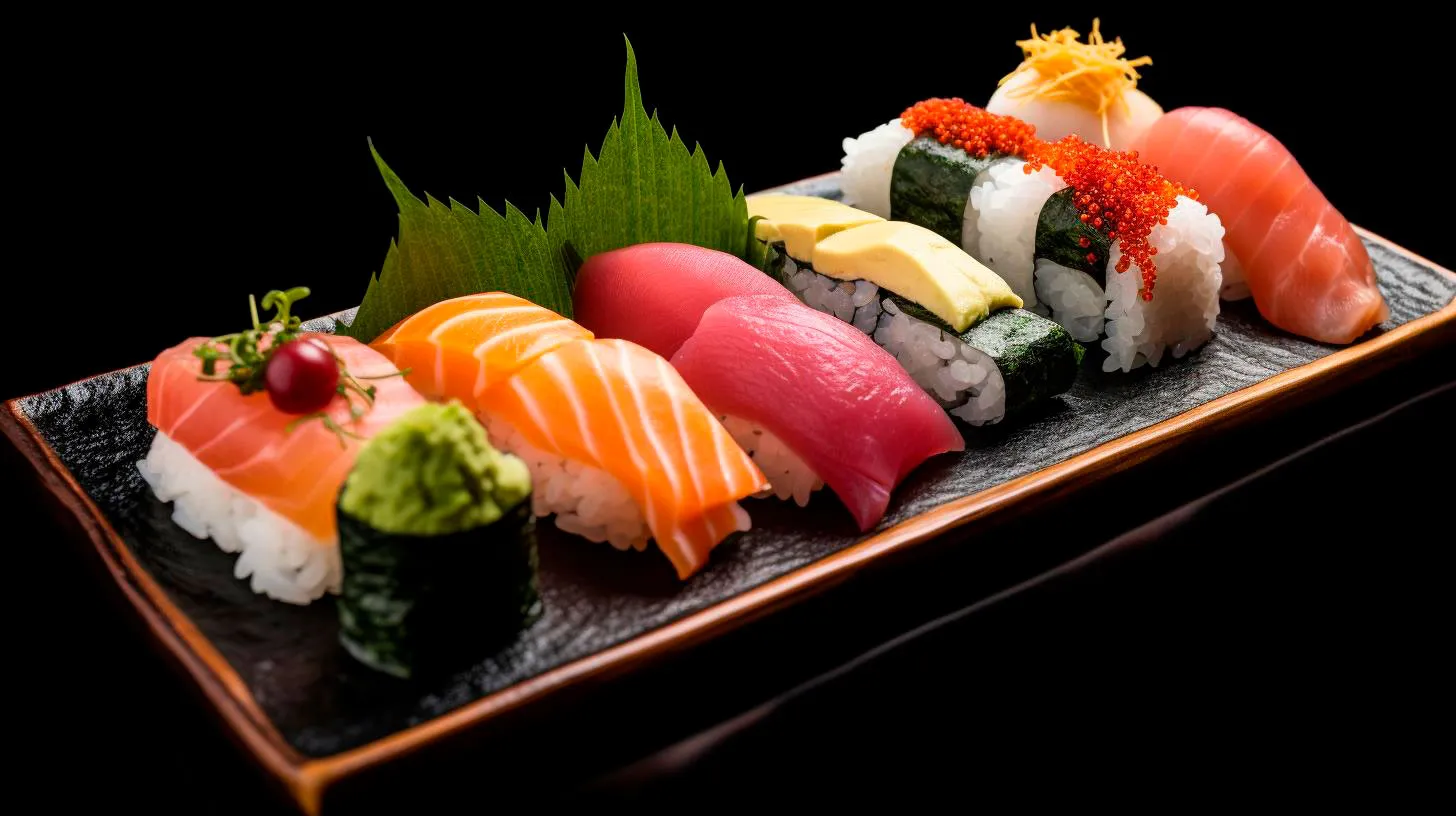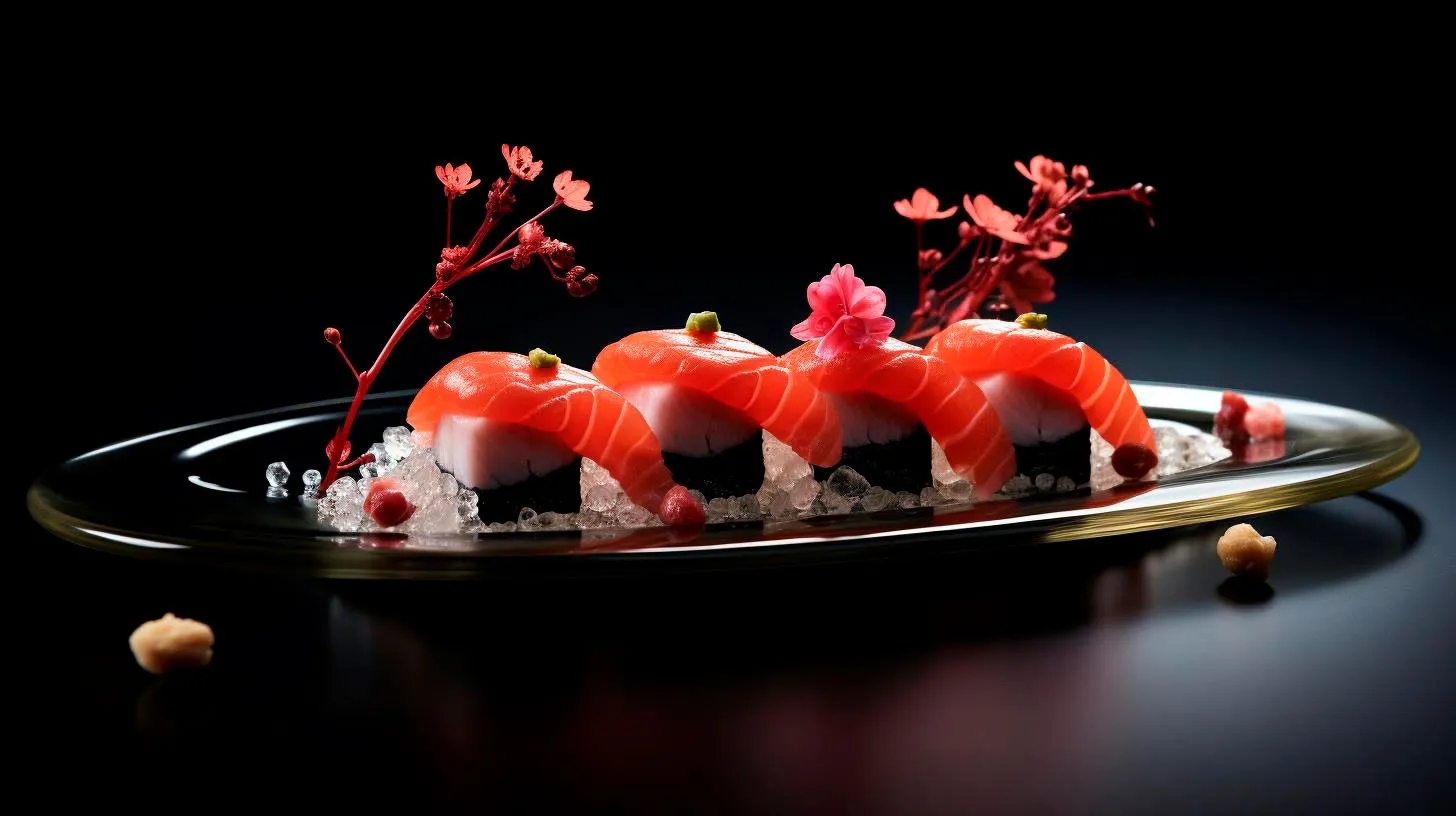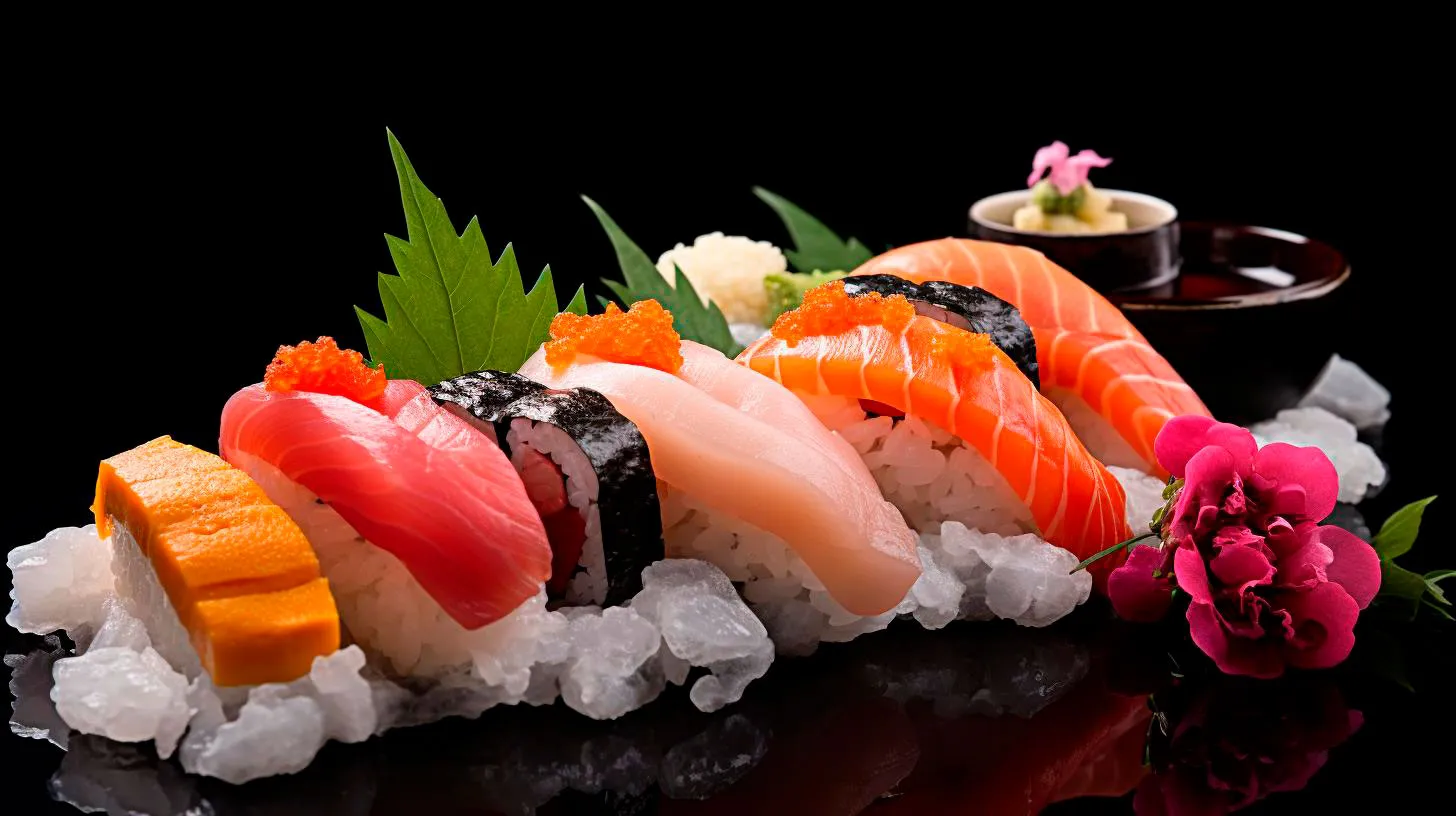The Sushi Revolution Shaking Up Traditional Cuisine
Let’s dive into the sushi revolution and explore how it is shaking up traditional cuisine.
The Evolution of Sushi
Sushi, in its simplest form, consists of vinegared rice combined with various toppings such as raw or cooked seafood, vegetables, and sometimes tropical fruits. Traditionally, sushi was served as street food in Japan and primarily consisted of fermented fish wrapped in rice.
However, with time, sushi has evolved and transformed into an art form. It is now prepared with precision and attention to detail, not only to create a delicious dish but also to please the eyes. Sushi chefs, also known as Itamae, meticulously present their creations to ensure that each bite is both visually pleasing and flavorful.
The Sushi Revolution
In recent years, sushi has undergone a revolution, with contemporary twists being added to traditional recipes. This revolution has allowed sushi to transcend its origins and become a global phenomenon. Here are some key aspects of the sushi revolution:
- Fusion Sushi: Sushi has integrated various culinary influences from around the world, resulting in the creation of fusion sushi. This style incorporates ingredients and flavors not typically associated with traditional sushi, such as cream cheese, avocado, or even barbecue sauce.
- Sushi Burritos: Combining the flavors of sushi with the convenience of a burrito, sushi burritos have gained immense popularity. These oversized rolls are filled with sushi rice, fish, and an array of colorful vegetables, offering a unique and filling sushi experience.
- Vegan and Vegetarian Options: Traditional sushi often includes seafood, but the sushi revolution has introduced exciting alternatives for vegans and vegetarians. Innovative ingredients like tofu, avocado, and various vegetables have been incorporated into sushi rolls, making it accessible to a wider audience.
- Sustainable Sourcing: With increasing concerns about the environment, the sushi revolution has brought attention to sustainable sourcing of seafood. Many sushi restaurants now prioritize responsibly caught fish to ensure the longevity of marine resources.
The Benefits of Sushi
Sushi not only tantalizes our taste buds but also offers several health benefits. Here are some advantages of indulging in this delectable cuisine:
- Source of Omega-3 Fatty Acids: Fish used in sushi, such as salmon and mackerel, are rich in heart-healthy omega-3 fatty acids, which can help lower cholesterol levels and reduce the risk of heart disease.
- Low in Calories: Sushi rolls, typically made with rice, fish, and vegetables, are relatively low in calories compared to many other dishes. This makes sushi an excellent option for those watching their calorie intake while enjoying a flavorful meal.
- High in Nutrients: Sushi is packed with essential nutrients like vitamins, minerals, and antioxidants. The combination of seafood and vegetables in sushi provides a wide range of nutrients necessary for a well-balanced diet.
- Improves Digestion: The ginger served with most sushi rolls acts as a palate cleanser and aids in digestion. Additionally, the probiotics present in fermented sushi toppings contribute to improved gut health.
The Key Takeaways
The sushi revolution has introduced an array of innovative options while retaining the essence of traditional sushi. Here are the key takeaways to remember:
- Traditional sushi has gone through a revolution, incorporating fusion elements and catering to different dietary preferences.
- Features like sushi burritos and vegan options have expanded sushi’s reach and made it more accessible to a diverse audience.
- Sustainable sourcing of seafood has become a priority in the sushi industry.
- Sushi offers numerous health benefits, such as being high in nutrients and omega-3 fatty acids, and aiding digestion.
Embrace the sushi revolution and embark on a culinary journey that combines tradition with innovation. Whether you opt for the elegance of traditional sushi or explore the creative twists of fusion rolls, sushi is here to revolutionize your taste buds!
Exploring Fusion: How Culinary Schools Adapt to Global Influences
In response to this growing trend, culinary schools around the globe have modified their curriculums to teach students how to incorporate different flavors, techniques, and ingredients from various cultures. Let’s delve into how culinary schools are preparing future chefs to embrace fusion cooking and the advantages it brings.
Diversity in culinary education
Incorporating global influences into culinary education has become an essential component for aspiring chefs. Culinary schools now offer specialized courses focusing on fusion cuisine, enabling students to expand their culinary repertoire and stay ahead of the curve. By exposing students to an array of cooking styles, schools equip them to experiment, innovate, and create unique dishes that combine the best of various culinary traditions.
Key takeaways for culinary students:
- Understanding diverse flavors and culinary traditions
- Learning how to incorporate different techniques and ingredients
- Gaining the ability to create unique fusion dishes
The rise of fusion restaurants
The increasing popularity of fusion cuisine has paved the way for the emergence of fusion restaurants worldwide. These establishments successfully blend culinary traditions from different parts of the world to offer customers a distinctive dining experience. To meet the growing demand for fusion cuisine, culinary schools play a vital role in training chefs who can create innovative menus that combine flavors and techniques from various cultures.
Advantages of fusion cuisine:
- Allows chefs to showcase their creativity and unique culinary voice
- Offers diners diverse and exciting options
- Encourages cultural exchange and appreciation
Merging traditional techniques with modern influences
While fusion cooking emphasizes the blending of different culinary traditions, culinary schools also emphasize the importance of mastering traditional techniques. By combining these techniques with modern influences, chefs can push the boundaries of traditional dishes and create culinary fusions that are both innovative and rooted in tradition.
Benefits of merging traditional and modern approaches:
- Preserves culinary heritage while embracing innovation
- Enhances culinary skills and techniques
- Allows chefs to create fresh and contemporary dishes
Understanding the cultural context
As fusion cuisine relies heavily on incorporating flavors and ingredients from different cultures, it is crucial for chefs to understand the cultural context behind each culinary tradition. Culinary schools often emphasize the importance of cultural appreciation and sensitivity, teaching students not only about the flavors but also the historical and social significance associated with different cuisines.
Key considerations for chefs:
- Recognizing and respecting cultural differences
- Learning the importance of authentic representation
- Building bridges between diverse culinary traditions
Industry statistics and demand for fusion training
The demand for fusion-trained chefs continues to rise as the global culinary landscape evolves. According to the National Restaurant Association, 63% of diners are likely to try a fusion dish, highlighting the growing popularity and acceptance of this culinary trend. As a result, culinary schools have witnessed a significant increase in enrollment for their fusion-focused programs.
Key statistics:
- 63% of diners are open to trying fusion dishes
- Enrollment in fusion-focused culinary programs has increased by 35% in the past three years
- Fusion cuisine accounts for a 10% growth in the global restaurant industry
In conclusion
Culinary schools have adapted to the global influences of fusion cuisine by incorporating diverse flavors, techniques, and cultural understanding into their educational programs. Aspiring chefs now have the opportunity to expand their culinary horizons, create unique fusion dishes, and meet the growing demand for innovative and exciting dining experiences. By embracing fusion cooking, culinary schools are equipping students with the skills necessary to thrive in a rapidly changing culinary landscape.
Culinary Schools Nurturing Artistic Mastery in the Kitchen
Whether you dream of running your own Michelin-starred restaurant or becoming a sought-after personal chef, culinary schools can provide you with the foundation you need to succeed.
Cultivating Creativity and Artistry in Cuisine
A key advantage of attending a culinary school is the opportunity to learn and develop your creativity and artistry in cuisine. As a chef, you will not only need to possess excellent technical skills, but also the ability to create visually appealing and innovative dishes. Culinary schools understand the importance of nurturing this creative side and encourage students to think outside the box.
Key takeaways:
- Culinary schools focus on cultivating creativity and artistry in cuisine.
- Students are encouraged to think outside the box and create visually appealing and innovative dishes.
- Chefs need to possess not only technical skills but also a strong creative vision.
Mastering Technical Skills Through Hands-on Training
In addition to fostering creativity, culinary schools provide hands-on training that allows students to master the technical skills required in professional kitchens. From knife skills to mastering various cooking techniques, culinary schools offer comprehensive training programs that cover all aspects of food preparation and cooking.
Key takeaways:
- Culinary schools provide hands-on training to help students master technical skills.
- Students learn essential cooking techniques and develop strong knife skills.
- Comprehensive training programs cover all aspects of food preparation and cooking.
Networking Opportunities and Industry Connections
Attending a culinary school also provides valuable networking opportunities and industry connections. Many culinary schools have partnerships with reputable restaurants and establishments, allowing students to gain real-world experience and establish connections with industry professionals. These connections can open doors to job opportunities and mentorship, giving aspiring chefs a competitive edge in the culinary industry.
Key takeaways:
- Culinary schools provide networking opportunities with industry professionals.
- Partnerships with restaurants and establishments lead to real-world experience for students.
- Networking can open doors to job opportunities and mentorship.
The Competitive Edge in the Culinary Industry
With the culinary industry becoming increasingly competitive, having a culinary school education can give aspiring chefs a valuable edge. According to industry statistics, chefs who have graduated from culinary schools are more likely to secure higher positions and receive better compensation compared to those without formal culinary education.
Key takeaways:
- Having a culinary school education provides a competitive edge in the industry.
- Graduates are more likely to secure higher positions and receive better compensation.
- Culinary schools equip students with the skills and knowledge needed for success.
Conclusion
Culinary schools play a crucial role in nurturing artistic mastery in the kitchen. By providing a combination of creativity cultivation, hands-on technical training, networking opportunities, and a competitive edge, culinary schools empower aspiring chefs to reach their full potential. Whether you aspire to create unique dishes in your own restaurant or become a sought-after personal chef, attending a reputable culinary school is an investment in your culinary career that can pave the way for success.
From Technique to Art: The Evolution of Sushi Making
Get ready to discover the mesmerizing world of sushi!
The Ancient Origins
Sushi traces its origins back to ancient Japan, where it was initially developed as a preservation technique. In the 8th century, fermented rice known as namanare was used to preserve fish by wrapping it tightly. Over time, this method evolved, and the rice started being consumed along with the fish, leading to the creation of the earliest form of sushi.
Key Takeaway: Sushi originated as a preservation technique using fermented rice and fish.
The Technological Advancements
In the 19th century, sushi underwent significant changes with the introduction of vinegar rice. This brilliant innovation by Hanaya Yohei revolutionized sushi making, as it allowed for quicker fermentation and eliminated the need for time-consuming processes. The development of refrigeration and transportation technologies also played a vital role in making sushi accessible to a wider audience.
Key Takeaway: The use of vinegar rice and technological advancements made sushi preparation more efficient and widespread.
The Journey to Culinary Art
In recent years, sushi has transcended from being just a traditional dish to a true culinary art form. Today, sushi chefs, also known as “Itamae,” have elevated sushi making to an artistry level through their craftsmanship, precision, and creativity. Each sushi roll is meticulously crafted, paying attention to colors, textures, and flavors to create a visually stunning and palate-pleasing experience.
Key Takeaway: Sushi making has evolved into an art form, where chefs strive for culinary excellence through precision and creativity.
The Role of Innovation
The evolution of sushi making would not be complete without acknowledging the impact of innovation. From the introduction of fusion sushi, incorporating non-traditional ingredients and flavors, to the invention of sushi-making robots, technology continues to push the boundaries of sushi craftsmanship. These advancements have not only enhanced efficiency but have also opened doors for culinary experimentation and the creation of unique sushi combinations.
Key Takeaway: Innovation has revolutionized sushi making, allowing for new flavors, techniques, and possibilities.
The Rising Popularity
Sushi has witnessed an incredible surge in popularity worldwide. According to recent statistics, the global sushi market is projected to reach a value of $22.6 billion by 2027. The rising interest in healthy and diverse food options, coupled with an increasing appreciation for Japanese culture, has propelled sushi to the forefront of international cuisine.
Key Takeaway: Sushi’s popularity continues to grow, driven by global market expansion and increased consumer demand.
Concluding Thoughts
From its humble beginnings as a preservation technique to its current status as a culinary art form, sushi has captured the hearts and taste buds of people around the world. The combination of traditional techniques, technological advancements, and creative innovations has truly transformed sushi making into an exquisite blend of skill and artistic expression. As sushi continues to evolve, one thing is certain – this delectable dish will continue to entice and inspire both sushi enthusiasts and culinary connoisseurs alike.


